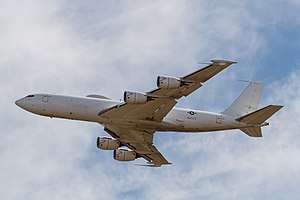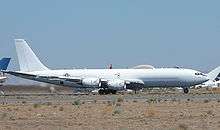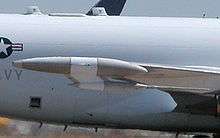Boeing E-6 Mercury
The Boeing E-6 Mercury (formerly E-6 Hermes) is an airborne command post and communications relay based on the Boeing 707-320. The original E-6A manufactured by Boeing's defense division entered service with the United States Navy in July 1989, replacing the EC-130Q. This platform, now modified to the E-6B standard, conveys instructions from the National Command Authority to fleet ballistic missile submarines (see communication with submarines), a mission known as TACAMO (TAke Charge And Move Out). The E-6B model deployed in October 1998 also has the ability to remotely control Minuteman ICBMs using the Airborne Launch Control System. The E-6B replaced Air Force EC-135Cs in the "Looking Glass" role, providing command and control of U.S. nuclear forces should ground-based control become inoperable. With production lasting until 1991, the E-6 was the final new derivative of the Boeing 707 to be built.[2]
| E-6 Mercury | |
|---|---|
 | |
| Boeing E-6 Mercury | |
| Role | Airborne command and control |
| Manufacturer | Boeing |
| First flight | 19 February 1987 |
| Introduction | August 1989 |
| Status | In service |
| Primary user | United States Navy |
| Number built | 16 |
| Unit cost |
US$141.7 million[1] |
| Developed from | Boeing 707-320 |
Design and development

Like the E-3 Sentry Airborne Warning and Control System (AWACS) aircraft, the E-6 is adapted from Boeing's 707-320 airliner. Rolled out at Boeing's Renton Factory on 18 December 1986,[3] the first E-6 made its maiden flight on 19 February 1987, when it was flown to nearby Boeing Field in south Seattle for fitting of mission avionics; it was delivered to the Navy for testing on 22 July 1988.
The E-6A, which was initially named Hermes, entered service with VQ-3 on 3 August 1989, with the second squadron, VQ-4 receiving its first E-6As in January 1991, allowing the EC-130Q to be phased out in June that year. The E-6A was renamed Mercury in autumn 1991 by request of the Navy;[4] sixteen were delivered from 1988 to 1992.[5]
The E-6B is an upgrade of the E-6A. It includes a battlestaff area and updated mission equipment. The flight deck systems were later replaced with an off-the-shelf 737 Next Generation cockpit. This greatly increases the situational awareness of the pilot and saves significant cost over the previous custom avionics package. The first E-6B was accepted in December 1997. All 16 E-6A aircraft were modified to the E-6B standard, with the final delivery taking place on 1 December 2006.[6]
Operational history
Codenamed Looking Glass, it is United States Strategic Command's (USSTRATCOM) Airborne Command Post (ABNCP), designed to take over in case the Global Operations Center (GOC), located at Offutt Air Force Base, Nebraska, is destroyed or incapable of communicating with strategic forces. The term "Looking Glass" is used because the ABNCP "mirrors" the abilities of the US Strategic Command GOC to control nuclear forces.[7]
The E-6 fleet is based at Tinker Air Force Base, Oklahoma, and operated by Fleet Air Reconnaissance Squadron 3 (VQ-3), VQ-4, and VQ-7.
Specifications

Data from Jane's all the world's aircraft, 1992–93[8] The US Navy -- Fact File: E-6B Mercury airborne command post[1]
General characteristics
- Crew: 22
- Length: 152 ft 11 in (46.61 m)
- Wingspan: 148 ft 2 in (45.16 m)
- Height: 42 ft 5 in (12.93 m)
- Wing area: 283.4 sq ft (26.33 m2)
- Empty weight: 172,795 lb (78,378 kg)
- Max takeoff weight: 342,000 lb (155,129 kg)
- Powerplant: 4 × CFM International CFM56-2A-2 turbofan engines
Performance
- Maximum speed: 530 kn (610 mph, 980 km/h) dash speed
- Cruise speed: 455 kn (524 mph, 843 km/h) at 40,000 ft (12,192 m)
- Range: 6,600 nmi (7,600 mi, 12,200 km)
- Combat range: 6,350 nmi (7,310 mi, 11,760 km)
- Endurance: 10 hours 30 minutes on station at 1,000 nmi (1,200 mi; 1,900 km) unrefuelled
- 28 hours 54 minutes with one refuelling
- 72 hours maximum with multiple refuellings
- Service ceiling: 40,000 ft (12,000 m)
- Wing loading: 112.13 lb/sq ft (547.5 kg/m2)
- Thrust/weight: 0.281
- Critical field length: 6,700 ft (2,042 m)
- Max effort Take-off run: 5,400 ft (1,646 m)
- Landing run at max landing weight: 2,600 ft (792 m)
Avionics
- AN/ARC-182 VHF/UHF TxRx
- AN/ARC-190 HF
- AN/AIC-32 Crew Intercom
- triplex Litton LTN-90
- LTN-211 VLF/Omega
- Smiths SFM 02 digital/analog flight management system
- AN/APS-133 colour weather radar
See also
Related development
Aircraft of comparable role, configuration and era
Related lists
References
Notes
- "The US Navy -- Fact File: E-6B Mercury airborne command post". www.navy.mil. 17 February 2009. Archived from the original on 16 June 2019. Retrieved 20 July 2019.
- Breffort, 2008. p. 235.
- "Boeing shows prototype of new jet". Lewiston Morning Tribune. (Idaho). Associated Press. 19 December 1986. p. 5B.
- Francillon 1995, p. 21.
- Breffort, 2008. p. 93
- Walsh, Madonna and Brad Mudd. "Boeing Delivers Final Upgraded E6-B to U.S. Navy." Archived 5 December 2006 at the Wayback Machine Boeing, 1 December 2006. Retrieved: 18 June 2011.
- "USSTRATCOM ABNCP Fact Sheet". Archived from the original on 20 April 2017. Retrieved 7 May 2017.
- Lambert, Mark; Munson, Kenneth; Taylor, Michael J.H., eds. (1992). Jane's all the world's aircraft, 1992–93 (83rd ed.). Coulson, Surrey, UK: Jane's Information Group. pp. 349–350. ISBN 0710609876.
Bibliography
- Francillon, René J. "Messenger of the Gods: The Boeing E-6 Mercury in USN Service." Air International, Vol. 48, No 1, January 1995, pp. 19–24.
- Breffort, Dominique. Boeing 707, KC-135 and Civilian and Military Versions. Paris: Histoire & Collections, 2008. ISBN 978-2-35250-075-9, pp. 93–94
External links
| Wikimedia Commons has media related to Boeing E-6. |